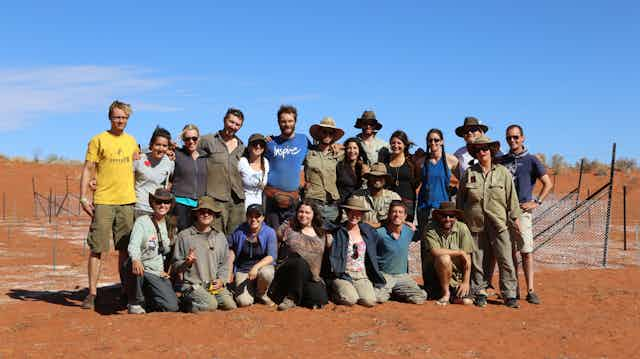Scientific discovery was once a mostly solitary endeavour and a common view was that genius was responsible for significant advances in knowledge.
The Nobel Prize – the ultimate prize for discovery – reinforces this perception by awarding no more than three people in each category each year for their contributions to science. Yet, increasingly, scientists are working in large collaborative teams to produce research of exceptional quality.
Ecologists were slower than other scientists to recognise the merit of collaboration. There is a longer history of collaboration among physicists and engineers, driven in part by the need to pool funds to buy equipment necessary for their research.
But ecologists don’t need expensive equipment to generate valuable data. In fact, many a dataset has been generated using a metal quadrat, a pencil and a notebook!
Simple equipment requirements belie the complexity of research problems modern-day ecologists are attempting to solve. Collaboration among ecologists can help this effort by increasing the availability and access to data.
Seeking general patterns and processes responsible for these patterns has long been the holy grail of ecology. Collaboration makes this quest achievable.
Nutrient Network
The Nutrient Network represents one successful model of collaboration in ecology. Initiated in 2007, the Nutrient Network is a cooperative globally distributed field experiment designed to understand the degree to which ecological trends uncovered at one site were repeated at multiple sites and in other environments.
From the outset, the coordinators recognised the importance of a simple experimental design. It also had to be inexpensive and easy to install for ecologists working in Serengeti savannah, Brazilian cerrado or Australian desert grasslands.
At last count, the network had grown from six sites in North America to 91 sites distributed across 19 countries around the world.
NutNet data are being used to explore important but largely unanswered questions in ecology. One such question seeks to understand whether a general pattern describes the relationship between productivity, as in yield or plant mass, and diversity, or the number of species, at different spatial scales from local to regional, to global.
The first set of data to describe the relationship was published in 1977. These data were collected from just 14 sites in the vicinity of Sheffield in the United Kingdom.
A more recent test of this relationship included data from 48 NutNet sites on five continents. The globally distributed experiment tested the generality of the pattern described in 1977.
Answers to NutNet questions have implications beyond their contribution to ecology. Increasing recognition of the impacts of human activity on Earth’s systems makes global datasets like these more valuable than ever before.
If diversity decreases with increased productivity, then conservation of diversity could be compromised in parts of the world experiencing nutrient enrichment.
For example, a regional study first pointed to the transforming effect of atmospheric nitrogen deposition on chalk grasslands in the Netherlands.
NutNet data have contributed to a broader understanding of the potential impacts of nitrogen deposition on herbaceous vegetation at multiple sites across the globe .
All these studies confirm that nitrogen enrichment increases productivity, which leads to a decline in diversity, presumably due to loss of plant species that can’t compete with the plants that grow bigger with more nitrogen.
New skills

Collaboration fosters a particular skill set not traditionally associated with nerdy scientists. Being social and working well with others towards a common goal is not what motivated me to study ecology.
I dreamt of working outdoors and learning about nature. Yet my interpersonal skills have become as important as my ability to count, to complete boring repetitive tasks, and to persist with the publication of my research despite sometimes harsh critical review.
Fortunately, the rewards of teamwork are rich in both the significance of what can be achieved and comradely support that develops among team members.
Ironically, collaboration can also foster nerdy scientists. Given the division of labour that comes with collaborative networks, some ecologists can sit at a computer analysing data that others have collected without ever setting foot on field sites. Indeed, ecology is increasingly reliant on people who can analyse and interpret complex datasets.
Collaboration offers a powerful approach to answer outstanding questions in ecology. Research papers having 15 or more contributing authors will soon be the norm.
Increased connectivity via the internet means that ecologists working “down under” are not excluded from collaborative networks. Actually, data from Australia are often highly sought after because the unique combination of climate, soils and species can challenge even the most widely accepted ideas.
Unlike the old perception of scientists as solitary creatures, the new norm is one of collaboration, often across continents.

